Urban Trees: Nature’s Highways for Wildlife in 2024
Introduction
In our rapidly expanding cities , urban trees are emerging as crucial lifelines for wildlife. As concrete jungles sprawl, these leafy giants create vital corridors, allowing animals to navigate through fragmented habitats. Let’s explore how urban trees are revolutionizing wildlife movement in our cities and why they’re more important than ever in 2024.
The Urban Jungle: A Challenge for Wildlife
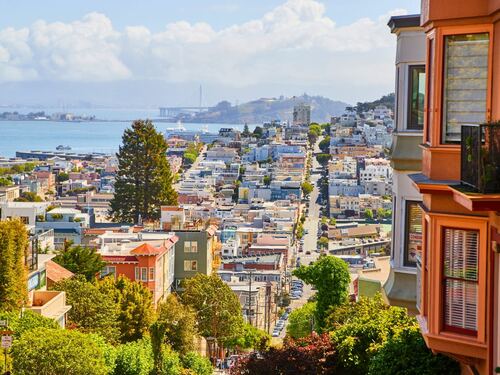
A Hilltop View of San Francisco
Urban fragmentation is the process by which natural habitats are divided into smaller, isolated patches due to city development. This fragmentation poses a significant threat to wildlife, disrupting their natural movement patterns and access to resources. The consequences are far-reaching, affecting not just large mammals but also birds, insects, and even plant species that rely on animal dispersal.
The USDA reports that that tree cover in urban and community areas of the United States is on the decline at a rate of about 175,000 acres per year, or about 36 million trees per year. This loss translates to a staggering reduction in habitat for urban wildlife. Animals that once roamed freely now find themselves trapped in small pockets of green, unable to access food, mates, or new territories.
Enter wildlife corridors—continuous strips of habitat that connect these fragmented areas. In urban settings, trees play a pivotal role in forming these corridors, creating “green highways” that allow animals to move safely through the urban landscape.
The Power of a Single Tree
Did you know that a single mature oak tree can support up to 2,300 different species ? This astounding fact underscores the importance of individual trees in urban ecosystems. Every tree serves as a miniature ecosystem, providing food, shelter, and a resting place for countless creatures.
From the roots to the canopy, trees offer a variety of microhabitats:
- Tree roots stabilize soil and provide homes for burrowing animals
- Tree bark houses insects and serves as a hunting ground for birds
- Leaves offer food for herbivores and shelter for small animals
- Branches provide nesting sites for birds and squirrels
- Tree cavities become homes for owls, woodpeckers, and bats
Even dead trees, often removed in urban settings, play a crucial role in ecosystems by providing homes for cavity-nesting birds and offering a food source for insect-eating species.
Urban Trees: Nature’s Unexpected Heroes
Urban trees are stepping up to the challenge of wildlife conservation in remarkable ways. By connecting fragmented habitats, they create lifelines for animals navigating the urban maze. These green corridors serve multiple functions:
- Movement Pathways: Allow animals to travel between larger habitat patches
- Stepping Stones: Provide rest areas for migrating species
- Habitat Expansion: Increases the effective size of habitat patches
- Climate Regulation: Creates microclimates that buffer against urban heat islands
- Pollution Reduction: Trees filter air pollutants, improving air quality for wildlife and humans alike
Types of Trees That Excel as Wildlife Corridors
Not all trees are created equal when it comes to supporting wildlife. Native species often provide the best habitat, as local animals have co-evolved with these plants. Some standout performers include:
- Oak Trees: Support a wide variety of insects, birds, and mammals. Their acorns are a crucial food source for many species.
- Maple Trees: Provide food for pollinators and nesting sites for birds. The winged seeds (samaras) are eaten by many bird species.
- Willow Trees: Excellent for supporting aquatic ecosystems and providing shelter. Their flexible branches are ideal for nest building.
- Pine Trees: Offer year-round shelter and are particularly important for winter wildlife. Their seeds are a vital food source for many bird species.
- Fruit Trees: While not always native, they provide abundant food sources for many urban animals, including birds and small mammals.
When planning urban tree corridors, a diverse mix of these species can create a rich, supportive environment for wildlife.
Success Stories: Urban Tree Corridors in Action
Cities worldwide are recognizing the power of urban tree corridors. In Singapore, the Park Connector Network links major parks with tree-lined paths, allowing wildlife to move between green spaces. This initiative has led to a 20 percent increase in urban biodiversity since its inception.
In Seattle, the Green Seattle Partnership has been working since 2005 to restore and maintain the city’s forested parklands. These efforts have resulted in the planting of over 200,000 trees, creating a network of green corridors throughout the city. The impact has been significant:
- A 30 percent increase in bird species diversity in restored areas
- The return of native amphibian species to urban wetlands
- Improved air quality and reduced urban heat island effect
Other cities are following suit. In Melbourne, Australia, the Urban Forest Strategy aims to increase canopy cover from 22 percent to 40 percent by 2040, creating biodiversity corridors that will allow native species to thrive in the urban environment.
Benefits of Urban Tree Corridors for Wildlife
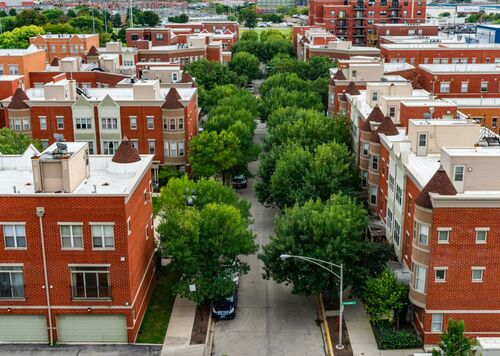
A Tree-Lined Street Provides Safety for Wildlife
The positive impacts of urban tree corridors extend far beyond simple connectivity.
Boosting Biodiversity
Urban tree corridors significantly increase biodiversity in cities. A 2024 study in the Journal of Urban Ecology found that neighborhoods with connected tree canopies had 40 percent higher bird species diversity compared to areas with isolated green patches. This increase in biodiversity isn’t limited to birds:
- Insect diversity , crucial for pollination and as a food source for other animals, can increase by up to 50 percent in areas with connected tree canopies.
- Small mammal populations, such as squirrels and rabbits, show greater genetic diversity in cities with well-connected green spaces.
- Native plant species often thrive in the understories of urban tree corridors, further enhancing biodiversity.
Improving Genetic Diversity
By allowing animals to move between populations, urban tree corridors help maintain genetic diversity. This is crucial for the long-term health and resilience of urban wildlife populations. Genetic diversity helps species adapt to changing environmental conditions, resist diseases, and maintain overall population health.
Reducing Wildlife-Human Conflicts
Well-designed urban tree corridors can help reduce conflicts between wildlife and humans. By providing alternative routes for animals, these green pathways can:
- Decrease the likelihood of wildlife entering residential areas in search of food or shelter
- Reduce road accidents involving wildlife by offering safe crossing points
- Minimize property damage caused by wildlife seeking resources in urban areas
Designing Effective Urban Tree Corridors
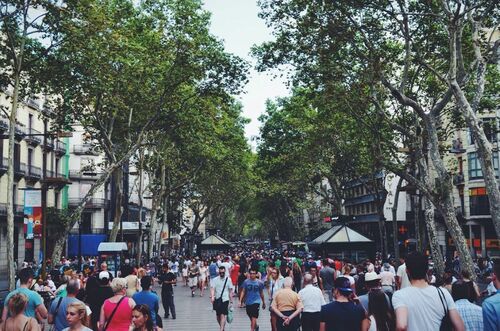
A Crowded Street Lined with Tall Trees – Image by Pavlo Luchovski
Creating successful wildlife corridors in urban areas requires thoughtful planning and design.
Key Features of Successful Wildlife Corridors
Effective urban tree corridors should:
- Provide continuous cover
- Offer a variety of native plant species
- Include different vegetation layers (ground cover, shrubs, and canopy)
- Connect to larger green spaces or natural areas
- Incorporate water sources
- Minimize light pollution
Importance of Tree Species Selection
Choosing the right tree species is crucial. Urban planners should consider:
- Native species that support local wildlife
- Trees with different fruiting and flowering times to provide year-round resources
- Species that can withstand urban stressors like pollution and heat
- Growth rate and mature size
- Structural diversity: A mix of coniferous and deciduous trees creates varied habitats
Integrating with Existing Green Spaces
To maximize their effectiveness, urban tree corridors should connect with:
- City parks
- Green belts
- Riverside vegetation
- Private gardens
- Green roofs and walls
Challenges in Implementing Urban Tree Corridors

A Squirrel Clings to a Tree Trunk in an Urban Setting
While the benefits are clear, creating urban tree corridors comes with its own set of challenges.
Space Constraints
In dense urban areas, finding space for new trees can be difficult. Creative solutions include:
- Green roofs and vertical gardens
- Transforming underused spaces into mini-forests
- Utilizing road medians and railway corridors
Balancing Human and Wildlife Needs
Urban planners must consider both human infrastructure needs and wildlife requirements. This often requires compromise and innovative design solutions:
- Multi-use Corridors: Designing green spaces that serve both wildlife and human recreation needs.
- Wildlife Bridges and Underpasses: These allow animals to safely cross roads and other barriers.
- Noise Reduction Strategies: Using vegetation buffers to minimize disturbance to wildlife.
- Education and Signage: Informing the public about the importance of wildlife corridors and how to interact safely with urban wildlife.
Maintenance and Sustainability
Long-term care of urban trees is crucial for their survival and effectiveness as wildlife corridors. This includes:
- Regular pruning and health checks
- Protection from vandalism and damage
- Adapting to impacts of changing weather patterns
- Invasive species management
- Soil health management
Community Involvement and Education
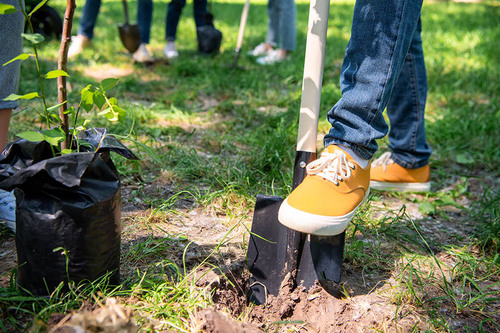
A Community Tree-Planting Event in Progress
The success of urban tree corridors relies heavily on community support and involvement.
Public Awareness and Support
Educating residents about the importance of urban trees for wildlife can foster support for tree planting and preservation initiatives. Strategies include community workshops, nature walks, social media campaigns, and citizen science projects.
Local Initiatives and Volunteer Programs
Many cities have successful volunteer programs for urban tree planting and maintenance. These programs not only help expand and maintain tree corridors but also foster a sense of community ownership and connection to nature.
Educational Programs
Schools can play a crucial role in educating the next generation about urban ecology. Programs that allow students to participate in tree planting or wildlife monitoring can create lasting connections to nature.
The Future of Urban Planning: Green Cities for All
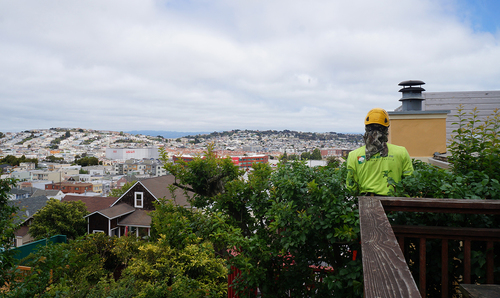
An Arborist Now Team Member Working with a City View
As we look into the future, urban tree corridors are set to play an increasingly important role in city planning.
Integrating Wildlife Corridors into Smart City Designs
Smart city technologies can help optimize the placement and maintenance of urban tree corridors. Digital mapping tools, IoT sensors , and AI algorithms can all contribute to more effective wildlife corridor design and management.
Innovative Technologies for Monitoring Wildlife Movement
New technologies are making it easier to track wildlife movement in cities. Motion-sensitive cameras, environmental DNA sampling, and citizen science apps allow researchers to gather data on how animals use urban tree corridors.
Policy Recommendations
To promote urban tree corridors, cities should consider:
- Implementing strong tree protection ordinances
- Requiring developers to include green corridors in new projects
- Offering incentives for private property owners to plant and maintain trees
- Developing comprehensive urban forest management plans
- Allocating dedicated funding for urban tree planting and maintenance programs
Conclusion
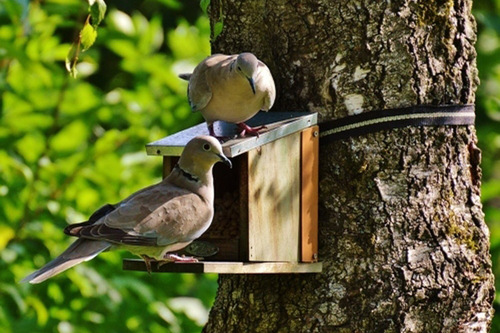
Pigeons Perch on an Urban Bird Feeder – Image by Alexas_Fotos on Pixabay
Urban trees are the unsung heroes of our cities, creating vital highways for wildlife in an increasingly fragmented landscape. By embracing and expanding these green corridors, we’re not just helping our animal neighbors—we’re creating healthier, more vibrant cities for everyone.
As we move forward, let’s remember that every tree planted is a step toward a wilder, more wonderful urban future. The next time you pass a city tree, take a moment to appreciate its role in supporting urban wildlife. These silent sentinels are working tirelessly to knit our fragmented urban ecosystems back together, one leaf at a time.
For more information on urban tree care and wildlife corridor creation, contact Arborist Now , your local experts in urban forest management and conservation. Together, we can transform our cities into thriving habitats where both humans and wildlife can flourish side by side.


